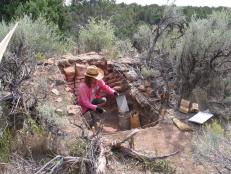Dracula Lives!


Getty Images
Bram Stoker staked his claim as the father of the modern vampire when his book Dracula introduced the Transylvanian count to the world in 1897. There are very few characters within pop culture as famous as Dracula, and the iconic vamp is even being resurrected in a new TV series this fall. And, of course, the Ghost Adventures crew of Zak, Nick and Aaron will be heading to Eastern Europe to explore the legend of Dracula’s inspiration, Vlad the Impaler, in a 2-hour special this coming Halloween.
But the power of blood within the Stoker legacy extends far beyond the lingering fascination with the count’s food source. In fact, Stoker’s family tree is still going strong, and the Dublin-born author is particularly well-represented by his great-grandnephew, Dacre Stoker.

So where does a Stoker descendant live? Instead of a foreboding castle situated in the Carpathian Mountains, I caught up with Dacre Stoker while he was fly-fishing in British Columbia. Here, he spoke about his great-granduncle and about representing the Stoker name.

Dacre Stoker: I’m not such a purist as to say that because they’re not the same as what Bram Stoker created, they’re wrong. I am quite the opposite. I think it is an homage to Bram that these creatures can morph and adapt to their surroundings and the entertainment world. If it was the same old “Bram Stoker’s Dracula,” and we never changed it, we’d be bored by now. I think it’s great.
Aaron Sagers: Which version of “Dracula” has resembled Bram’s the most, in your opinion?
Dacre Stoker: Gary Oldman in the 1992 Coppola version (Bram Stoker’s Dracula) had the ability to change like crazy during the movie … writers like Anne Rice have given these guys morals and they have dilemmas, and have to worry about killing people for love or pure food. So there are many more dimensions today. And you have to remember, Bram allowed his vampire to shape-shift into mist, wolf, bat. Now they’re changing into the cute guy next door or this hot girl, and it’s all adaptation. And it works, I think, and it’s fantastic.

Dacre Stoker: You're absolutely right. Sometimes the bad does, or the “bad” at the time, do produce good. Just imagine if that one copy of Nosferatu didn't survive, you know? At the time it's not what Florence would have wanted or what the courts ruled, but thank goodness that it did survive because it sort of was the spark that helped create this whole genre.
Aaron Sagers: And without Lugosi, would we still care about “Dracula” so many years later?
Dacre Stoker: That’s a tough call. Christopher Lee did a hell of a job with his portrayal, but Lugosi was the first to take it to the stage and then to the movies. Who knows? If it didn’t bridge that initial gap from the pages of the book to the stage, maybe it would never have picked up.
Aaron Sagers: Do you think Bram intended vampires to be the sexy creatures we’ve come to think of them as?
Dacre Stoker: I don’t think so at all. His research indicates he was looking into this horrifying revenant that comes out of the grave and takes on life, and is looking for more life to sacrifice for his own. He was not a debonair sexy guy. Even though that may not have been Bram’s intention, it doesn’t mean it’s not good. You have got to be an entertainer, and writers have to move with what the audience wants. There’s a lot of people out there reading the books and watching the movies, so somebody must be doing something right with these, let’s call them, “new Draculas.”

Dacre Stoker: I know where you're going with this. It took a little while, yes. It was tough getting into the story style. But I do remember this, when I got into it, and it was about the second read, I started realizing how this style was working with different people’s points of view through diaries and journal entries and so on.
Aaron Sagers: What has changed the most for you since embracing the Bram Stoker legacy?
Dacre Stoker: It used to be around Halloween, me and my cousins would all joke, “OK, how many strange requests have you got? Or how many people remember you're a Stoker around Halloween?” But I think the biggest thing that's changed is I feel a duty to the family. And my wife and I have really dug into research into the family, trying to bring recognition to Bram not only as the writer of Dracula but as a well-rounded person who was well-thought-of around the world. And so that's changed.
Aaron Sagers: Do you feel a weight or pressure, being a direct descendant of Bram, to carry on his legacy?
Dacre Stoker: I do a little bit. So many people over the years have jumped to ridiculous speculation [based] on partial bits of knowledge that they’ve pulled out of hearsay. Some biographies about Bram have inaccuracies that have created a proliferation of mistakes.

Dacre Stoker: He was not just the guy who wrote Dracula and was Henry Irving’s theater manager. Everyone says Bram was second fiddle to Irving, but Bram helped create a persona for Irving, and Irving played it on and off stage to perfection -- to the point where he became the first actor to be knighted. Bram was creative. He wrote all kinds of books, and wasn’t just some boring, dull bean counter second fiddle to Irving. He was prominent and carved out important friendships with important people at the time. He was an innovator in many things and into new science and technology, and inserted that into Dracula. He was a good friend of Mark Twain and an investor in a new type of typewriter that Twain was working on.
Aaron Sagers: And he was a pen pal of Walt Whitman -- how did that impact him?
Dacre Stoker: I think Whitman provided Bram Stoker with the impetus to write freely and allow himself to release the constraints of the very Victorian society he was living in, in Ireland and England. Whitman didn’t have those constraints, and Bram admired that. When they finally met, Whitman was very ill and they didn’t spend a lot of time together, but they had great respect for one another. He actually gave Bram his notes for his famous speech on Abraham Lincoln.
Aaron Sagers: In the time you’ve been appearing as a Stoker descendant, what has been your craziest experience?
Dacre Stoker: Halloween is like the Super Bowl for the Stoker family. It comes once a year and everyone wants a piece of you, and it’s wonderful and exciting. I go to these different events, and the most bizarre thing was a woman who lived the vampire life who asked me, very seriously, if she could have a sample of the Stoker blood. She wanted to have some of the Stoker DNA, but I had to say I’m not into that sort of thing … I told her she could have some of my time and chat.
Aaron Sagers: Has anyone made a set of fangs for you?
Dacre Stoker: I don’t do the fang thing, but when I do these things I try to dress as Bram, the theater manager, in tails and white tie.

Dacre Stoker: I’m working on a travel guide at the moment about places where Bram grew up and where he was inspired to write Dracula, and the real places in Romania where the “real” Dracula moved and did his thing, as well as the places Bram chose for his book. It will help groups of people literally trace the path that Bram did his research on, and where the book took place. Also, Bram’s Dracula was not exactly based on the real Vlad Dracula … so we fill in all kinds of information about the real Vlad and show where the overlap is. And I’m working on a “Dracula” adaptation on stage through October -- the big night will be on Halloween night in Columbia, SC, at the High Voltage Theatre. I will also be doing the “Stoker on Stoker” presentations, along with a group called Historical Haunts, who put out a cool documentary about vampires in New England and different places leading up to Halloween.


























.jpg.rend.hgtvcom.231.174.suffix/1674758726773.jpeg)











